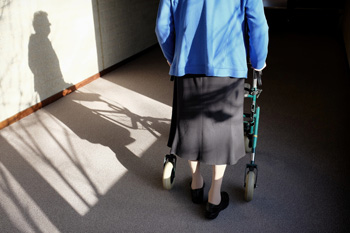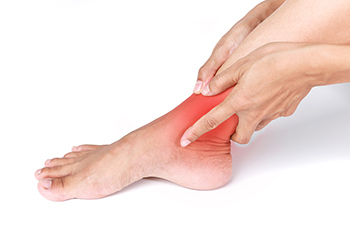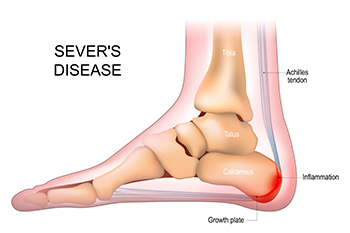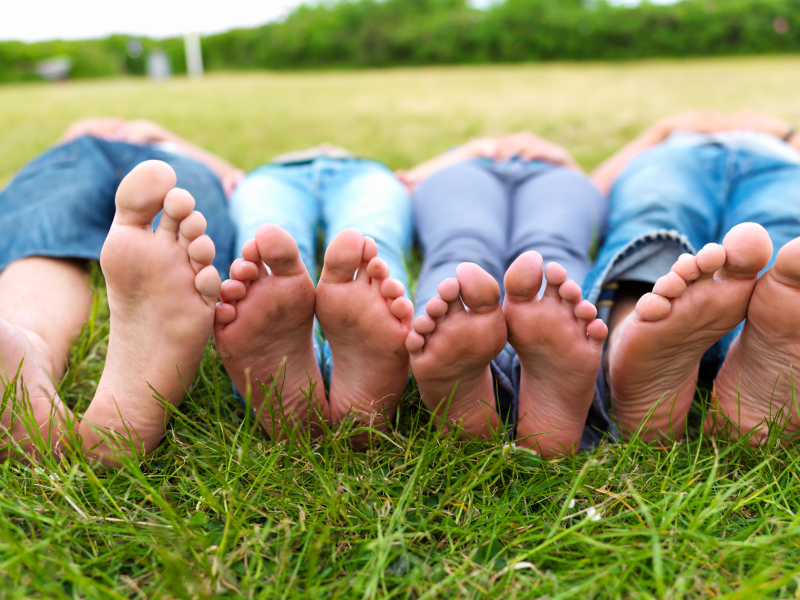Items filtered by date: October 2023
Foot Problems in the Elderly Population

The elderly are more prone to foot problems due to a combination of age-related physical changes, accumulated wear and tear, and other health factors. As people age, the skin becomes thinner, less elastic, and loses its natural oils, making it more susceptible to dryness, cracking, and infections. The fat pads on the bottom of the feet, which provide cushioning, tend to thin out, leading to decreased shock absorption and increased sensitivity to pressure points. Additionally, circulation can diminish, slowing down the healing process and increasing the risk of infections. Over time, joints can become stiff and lose their range of motion due to conditions such as arthritis. Chronic diseases including diabetes can also have significant effects on foot health, increasing vulnerability to nerve damage and poor circulation. Years of bearing body weight and wearing various types of footwear can result in structural changes like bunions, hammertoes, and collapsed arches. If you are elderly or taking care of an older person, it is suggested that you routinely schedule appointments with a podiatrist for examinations and regular foot care.
Proper foot care is something many older adults forget to consider. If you have any concerns about your feet and ankles, contact one of our podiatrists from Centers for Foot & Ankle Care. Our doctors can provide the care you need to keep you pain-free and on your feet.
The Elderly and Their Feet
As we age we start to notice many changes in our body, but the elder population may not notice them right away. Medical conditions may prevent the elderly to take notice of their foot health right away. Poor vision is a lead contributor to not taking action for the elderly.
Common Conditions
- Neuropathy – can reduce feeling in the feet and can hide many life-threatening medical conditions.
- Reduced flexibility – prevents the ability of proper toenail trimming, and foot cleaning. If left untreated, it may lead to further medical issues.
- Foot sores – amongst the older population can be serious before they are discovered. Some of the problematic conditions they may face are:
- Gouging toenails affecting nearby toe
- Shoes that don’t fit properly
- Pressure sores
- Loss of circulation in legs & feet
- Edema & swelling of feet and ankles
Susceptible Infections
Diabetes and poor circulation can cause general loss of sensitivity over the years, turning a simple cut into a serious issue.
If you have any questions please feel free to contact one of our offices located in Merrillville, Portage, Michigan City/LaPorte, and Schererville, IN . We offer the newest diagnostic and treatment technologies for all your foot and ankle needs.
Risk Factors and Symptoms of Ankle Gout

Gout is a painful form of inflammatory arthritis that can affect various joints in the body, usually the big toe. When it strikes the ankle, it's referred to as ankle gout. This condition can be identified by sudden and intense pain, swelling, and redness in the affected joint. The root cause of gout in the ankle is a buildup of uric acid. This waste product is produced during the breakdown of purines, which are found in certain foods, like red meat and seafood. Normally, your body transports uric acid to the kidneys for elimination in urine. But if not properly flushed out, excessive uric acid remains in the bloodstream, termed hyperuricemia. Eventually, uric acid crystals can accumulate in certain joints, including the ankle joint, and cause the classic symptoms of pain, swelling, and redness. Gout flares usually peak within 12 to 24 hours of onset and gradually improve over one to two weeks, with or without treatment. Some individuals may experience only one gout flare in their lifetime, while others suffer from recurring flares. In cases of recurring gout flares, symptoms can become more severe and prolonged, potentially leading to joint damage. If you suspect you have ankle gout, it is suggested that you make an appointment with a podiatrist for a proper diagnosis and more advanced treatment options.
Gout is a painful condition that can be treated. If you are seeking treatment, contact one of our podiatrists from Centers for Foot & Ankle Care. Our doctors will treat your foot and ankle needs.
What Is Gout?
Gout is a form of arthritis that is characterized by sudden, severe attacks of pain, redness, and tenderness in the joints. The condition usually affects the joint at the base of the big toe. A gout attack can occur at any random time, such as the middle of the night while you are asleep.
Symptoms
- Intense Joint Pain - Usually around the large joint of your big toe, and it most severe within the first four to twelve hours
- Lingering Discomfort - Joint discomfort may last from a few days to a few weeks
- Inflammation and Redness -Affected joints may become swollen, tender, warm and red
- Limited Range of Motion - May experience a decrease in joint mobility
Risk Factors
- Genetics - If family members have gout, you’re more likely to have it
- Medications - Diuretic medications can raise uric acid levels
- Gender/Age - Gout is more common in men until the age of 60. It is believed that estrogen protects women until that point
- Diet - Eating red meat and shellfish increases your risk
- Alcohol - Having more than two alcoholic drinks per day increases your risk
- Obesity - Obese people are at a higher risk for gout
Prior to visiting your podiatrist to receive treatment for gout, there are a few things you should do beforehand. If you have gout you should write down your symptoms--including when they started and how often you experience them, important medical information you may have, and any questions you may have. Writing down these three things will help your podiatrist in assessing your specific situation so that he or she may provide the best route of treatment for you.
If you have any questions, please feel free to contact one of our offices located in Merrillville, Portage, Michigan City/LaPorte, and Schererville, IN . We offer the newest diagnostic and treatment technologies for all your foot care needs.
Causes and Treatment Options for Sever’s Disease

Sever's disease, also known as calcaneal apophysitis, is a common heel condition affecting children during growth spurts. The primary cause lies in the heel bone's growth plate, which is still developing and can become inflamed due to repetitive stress and tension. This often occurs in active children involved in sports or activities that involve a lot of running and jumping. The growth plate is more vulnerable during this period of rapid growth, making it susceptible to injury and irritation. The good news is that Sever's disease is manageable and typically resolves on its own as the growth plate solidifies. Treatment involves rest, modifying activities, stretching exercises, and wearing supportive footwear to alleviate symptoms and promote healing. If your active child has heel pain, which is a common symptom of Sever’s disease, it is suggested that you consult a podiatrist. This type of doctor can offer tailored treatment options for this condition.
Sever's disease often occurs in children and teens. If your child is experiencing foot or ankle pain, see one of our podiatrists from Centers for Foot & Ankle Care. Our doctors can treat your child’s foot and ankle needs.
Sever’s Disease
Sever’s disease is also known as calcaneal apophysitis, which is a medical condition that causes heel pain I none or both feet. The disease is known to affect children between the ages of 8 and 14.
Sever’s disease occurs when part of the child’s heel known as the growth plate (calcaneal epiphysis) is attached to the Achilles tendon. This area can suffer injury when the muscles and tendons of the growing foot do not keep pace with bone growth. Therefore, the constant pain which one experiences at the back of the heel will make the child unable to put any weight on the heel. The child is then forced to walk on their toes.
Symptoms
Acute pain – Pain associated with Sever’s disease is usually felt in the heel when the child engages in physical activity such as walking, jumping and or running.
Highly active – Children who are very active are among the most susceptible in experiencing Sever’s disease, because of the stress and tension placed on their feet.
If you have any questions, please feel free to contact one of our offices located in Merrillville, Portage, Michigan City/LaPorte, and Schererville, IN . We offer the newest diagnostic and treatment technologies for all your foot and ankle injuries.
Gout Pain Can Be Managed
Footwear and Children’s Foot Health

Active kids take about 20,000 steps a day, making the choice of shoes important for their foot health. Conventional shoes can distort natural foot structures, leading to musculoskeletal issues over time. Adult feet and conventional adult shoes share a similar shape, which is not a coincidence. Many foot problems, such as bunions and heel pain, that are seen in western societies are rare in cultures where people walk mostly barefoot. This may suggest that certain footwear affects foot shape negatively. Parents can opt for children’s shoes that are widest at the toes, flat, lightweight, and have flexible soles. Avoid arch support or pronation control features as these can interfere with natural foot development. It is also acceptable to allow your child to walk barefoot occasionally, as feet are adaptable. However, always be cautious about unsafe surfaces. Making these simple choices can contribute to the healthy development of your child’s feet. If you want to make sure that your child’s feet have the best chance of developing healthfully, it is suggested that you make an appointment with a podiatrist for an evaluation and discussion on how to best do this.
Making sure that your children maintain good foot health is very important as they grow. If you have any questions, contact one of our podiatrists of Centers for Foot & Ankle Care. Our doctors can provide the care you need to keep you pain-free and on your feet.
Keeping Children's Feet Healthy
Having healthy feet during childhood can help prevent medical problems later in life, namely in the back and legs. As children grow, their feet require different types of care. Here are some things to consider...
Although babies do not walk yet, it is still very important to take care of their feet.
Avoid putting tight shoes or socks on his or her feet.
Allow the baby to stretch and kick his or her feet to feel comfortable.
As a toddler, kids are now on the move and begin to develop differently. At this age, toddlers are getting a feel for walking, so don’t be alarmed if your toddler is unsteady or ‘walks funny’.
As your child gets older, it is important to teach them how to take care of their feet.
Show them proper hygiene to prevent infections such as fungus.
Be watchful for any pain or injury.
Have all injuries checked by a doctor as soon as possible.
Comfortable, protective shoes should always be worn, especially at play.
If you have any questions please feel free to contact one of our offices located in Merrillville, Portage, Michigan City/LaPorte, and Schererville, IN . We offer the newest diagnostic and treatment technologies for all your foot and ankle needs.
Clubfoot Is a Congenital Foot Deformity

Clubfoot is a congenital foot deformity that affects thousands of newborns worldwide. This condition is characterized by an abnormal positioning of the foot, where it turns inward and downward, making it appear like the sole is turned upward. While the exact cause of clubfoot is still not entirely understood, it is believed to result from a combination of genetic and environmental factors during fetal development. Typically, clubfoot can be detected shortly after birth. Early diagnosis and intervention are essential for effective treatment. The goal of treatment is to correct the foot's positioning and allow for normal growth and development. This often involves a series of gentle manipulations, casting, and sometimes minor surgery. With early and appropriate medical care, most children born with clubfoot can lead normal, active lives. Regular follow-ups may be necessary to monitor the foot's growth and function, but the prognosis for those with clubfoot is generally positive. The key is prompt identification and intervention to ensure a healthy and active future for affected children. If your child has been born with clubfoot, it is strongly suggested that you are under the care of a podiatrist who can begin the necessary treatment methods.
Congenital foot problems require immediate attention to avoid future complications. If you have any concerns, contact one of our podiatrists of Centers for Foot & Ankle Care. Our doctors can provide the care you need to keep you pain-free and on your feet.
Congenital foot problems are deformities affecting the feet, toes, and/or ankles that children are born with. Some of these conditions have a genetic cause while others just happen. Some specific foot ailments that children may be born with include clubfeet, polydactyly/macrodactyly, and cleft foot. There are several other foot anomalies that can occur congenitally. What all of these conditions have in common is that a child may experience difficulty walking or performing everyday activities, as well as trouble finding footwear that fits their foot deformity. Some of these conditions are more serious than others. Consulting with a podiatrist as early as possible will help in properly diagnosing a child’s foot condition while getting the necessary treatment underway.
What are Causes of Congenital Foot Problem?
A congenital foot problem is one that happens to a child at birth. These conditions can be caused by a genetic predisposition, developmental or positional abnormalities during gestation, or with no known cause.
What are Symptoms of Congenital Foot Problems?
Symptoms vary by the congenital condition. Symptoms may consist of the following:
- Clubfoot, where tendons are shortened, bones are shaped differently, and the Achilles tendon is tight, causing the foot to point in and down. It is also possible for the soles of the feet to face each other.
- Polydactyly, which usually consists of a nubbin or small lump of tissue without a bone, a toe that is partially formed but has no joints, or an extra toe.
- Vertical talus, where the talus bone forms in the wrong position causing other bones in the foot to line up improperly, the front of the foot to point up, and the bottom of the foot to stiffen, with no arch, and to curve out.
- Tarsal coalition, when there is an abnormal connection of two or more bones in the foot leading to severe, rigid flatfoot.
- Cleft foot, where there are missing toes, a V-shaped cleft, and other anatomical differences.
- Macrodactyly, when the toes are abnormally large due to overgrowth of the underlying bone or soft tissue.
Treatment and Prevention
While there is nothing one can do to prevent congenital foot problems, raising awareness and receiving neonatal screenings are important. Early detection by taking your child to a podiatrist leads to the best outcome possible.
If you have any questions please feel free to contact one of our offices located in Merrillville, Portage, Michigan City/LaPorte, and Schererville, IN . We offer the newest diagnostic tools and technology to treat your foot and ankle needs.

